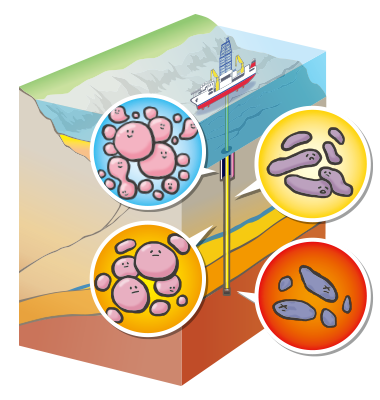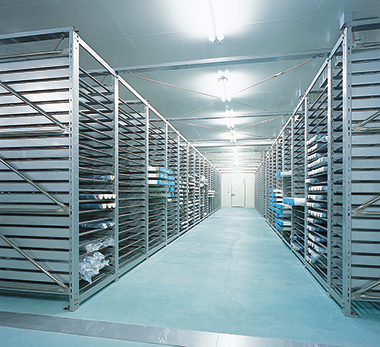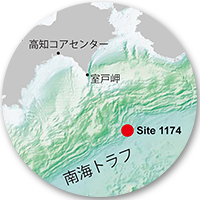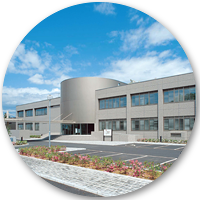Q. What is the subseafloor biosphere?
A.
In the course of nearly 50 years of scientific ocean drilling, the discovery of microbial life in the deep sub-seafloor was at first unexpected and surprising, but to date active microbial communities have been found almost everywhere, even in sediments below the nutrient-poor ocean gyres, in basement rocks, and at depths of ~2.5 km. We investigate the deep sub-seafloor biosphere because we want to shed light on one of the largest continuous ecosystems on Earth. Presumably, the sub-seafloor contains as many microbial cells as all the water in the global oceans. Over the last decade, estimates of the size of the sub-seafloor biosphere have been refined several times, but its exact size is still a matter of debate. Possibly, life ceases at a certain depth where sediments and rocks become too hot because of geothermal heating. But what is this depth exactly? So far, we know neither which factors pose ultimate limits to life in the sub-seafloor, nor where the bottom of the deep biosphere is located.
Q. What do you expect to “limit” the subseafloor biosphere?
A.
Expedition 370 aims to study the composition, function, and activity of microbial communities in deep, ~30 - 130°C sub-seafloor environments, because this temperature range covers the putative upper temperature limit of microbial life in anoxic sediments. Heat could limit life in the sub-seafloor directly via denaturation of biomolecules or indirectly via thermal alteration of the habitat. Therefore, we will characterize both the chemical and physical environment. Moreover, we will investigate if the thermal decomposition of organic matter during sediment burial goes along with a stimulation or inhibition of microbial activity.
Q. What was the motivation to do a drilling research at Nankai Trough?
A.
When searching for a suitable site for our investigations, we found the Nankai Trough off Muroto most promising. At this part of the subduction boundary between the young, hot Philippine Sea plate and the Eurasian plate, subseafloor heat flow is particularly high. As the geothermal gradient is about four times steeper than elsewhere, we will presumably enter up to ~130°C sediments if we drill only 1.2 km deep into the seafloor. At other places, we would need a ~4 km deep borehole to address our research questions, and drilling would be much more complex and expensive. Furthermore, the Nankai Trough has been intensively studied by previous investigations, further making it an ideal location for the planned research. The existing data sets are invaluable for the development of specific research questions, operational plans, sampling plans, and plans for post-cruise research.
Q. What is unique about the drilling site?
A.
Our drilling site is located in the vicinity of ODP Sites 808 and 1174, which were drilled during Ocean Drilling Program (ODP) Legs 131 and 190 in 1990 and 2000, respectively. The site is located ~125 km offshore Shikoku Island, in the protothrust zone of the accretionary prism at a water depth of 4765 m.
This location is a first-class target for in-depth examination of subseafloor microbial life approaching its upper temperature limit for several reasons. Firstly, the geothermal gradient of ~100°C/km is ideal for addressing our research questions. As I mentioned, we can sample the putative temperature-dependent biotic–abiotic transition zone at relatively shallow sediment depth, but compared to sites with even higher geothermal gradients, as found for example at hydrothermal vents in the Okinawa Trough, the temperature increases still gradually enough for the establishment of distinct, thick depth horizons (>10 m) with suitable conditions for psychrophilic (optimal growth temperature range: <20°C), mesophilic (20-45°C), thermophilic (45-80°C) and hyperthermophilic (>80°C) microorganisms. At the selected site, we will be able to explore the putative biotic fringe at a relatively shallow depth, but with high resolution of the temperature gradient.
Secondly, existing data already point to the presence of an important geobiological transition at this site. At Site 1174, concentrations of microbial cells decrease gradually with depth until they drop abruptly to non-detectable levels at sediment depths of around 800 mbsf, where estimated in situ temperatures exceed 85–90°C. Moreover, Site 1174 is potentially influenced by fluid flow along the decollement and basement, and the deep seated fluids might stimulate life at the lower end of the deep subseafloor biosphere via introduction of (hyperthermophilic) microorganisms, nutrients and electron acceptors.
Last but not least, the site is located in close vicinity to the Kochi Core Center (KCC), where first class equipment is available to investigate of microbial communities and processes close to the limits of life. This allows us to transfer critical cores rapidly via helicopter from Chikyu to KCC, where a shorebased group of expedition scientists will conduct time-sensitive analysis with cutting-edge technology.

Q. Why do you drill again in the vicinity of previously drilled site?
A.
Since Site 1174 was drilled and sampled 16 years ago, analytical methods have advanced tremendously, particularly in cell quantification, molecular microbiology, and molecular and isotopic geochemical techniques. For example, microbial cells were counted manually during ODP Leg 190, using acridine orange to stain microbial cells and a microscope onboard the D/V Joides Resolution. The minimal quantification limit was ~60,000 cells per cm3. Using automated microscopic counting techniques, clean room technology, and contamination control, we can now detect cell concentrations as low as 10 cells per cm3, for example in deep sub-seafloor sediments off the Shimokita Peninsula, Japan, where we detected indigenous microbial cells down to 2.4 kmbsf (~60°C) (Inagaki et al, 2015). The sensitivity of other microbiological and geochemical techniques has advanced in a similar fashion. We now aim to revisit Site 1174 with a multidisciplinary team of scientists tackling novel questions and equipped with an innovative toolbox for the interrogation of microbial life and geomicrobial processes at the biotic-abiotic transition, which we expect to occur where the abrupt drop in cell concentrations was previously observed.
In order to investigate the temperature limit of life in the deep sub-seafloor biosphere, robust information on in situ temperatures will be very important. In the vicinity of Site 1174, high heat flow has been observed in various studies, but Leg 190 achieved only two reliable downhole temperature measurements, and the resulting estimates of in situ temperatures bear considerable uncertainty. In order to generate robust downhole temperature data, Expedition 370 will install a temperature observatory in the borehole for long term observations. In this manner, a revisit of Site 1174 will also help to better characterize the overall hydrothermal regime of the Nankai Trough subduction zone.
Q. What kinds of analyses are you scientists going to do during the Expedition 370?
A.
The team of expedition scientists will consist of microbiologists, organic and inorganic geochemists, biogeochemists, physical properties specialists, sedimentologists, structural geologists, and paleomagnetists, who will perform a large variety of analysis on the recovered sediment cores and basement rocks. Three types of analysis will be crucial for the expedition goals. These are quality assurance/quality control (QA/QC) including contamination assessments, time-sensitive (bio-)geochemical and microbiological analyses, and stratigraphy for the correlation of our samples with data generated from other boreholes.
After core recovery, samples will be scanned immediately by a shipboard medical X-ray CT scanner. This nondestructive testing allows us to visualize the internal structure of sediments within the retrieved core, and is highly useful for the identification of undisturbed intervals. Only the latter will be subsampled for (bio-)geochemical and microbiological analyses. To further ensure that the selected sediment intervals have not been contaminated during drilling, we will add a chemical tracer to the drilling fluid and track its presence inside the sediment cores. The laboratories onboard the Chikyu are very well equipped for geochemical analysis, and thus a set of routine gas, interstitial water and solid phase analyses can be performed onboard. This is of particular importance for ephemeral parameters, such as pore-water nutrient concentrations. For analysis that require more sophisticated instrumentation, samples will be preserved and shipped to specialized laboratories. For the investigation of microbial life close to the limit of detection, the contamination-free handling of sediment cores is a key requirement.
Q. What is challenging about this expedition?
A.
The expedition will be challenging in many ways. The drilling engineers need to deal with a difficult geological formation. We expect thick turbidite layers, fractures and brittle sediments that can create issues for borehole stability as well as for core recovery and quality. We plan to set casing in order to keep the borehole open, and we are prepared to test new coring techniques in order to obtain the best possible cores. Strong Kuroshio Current makes such operation even more difficult.
Scientifically, microbiologists and biogeochemists will be challenged by the very low biomass at the biotic fringe. We will need to generate high quality data sets close to the detection limit of our methods, and we are ready to push the limits through careful contamination control, large sample volumes, carefully coordinated research plans, utilization of research facilities at KCC, and involvement of excellent scientists from all over the world. Moreover, reliable information on in situ temperatures is extremely important, and downhole temperature measurements are everything but trivial. This is particularly true in a setting where in situ temperatures exceed the temperature limit of standard sensors and devices for data storage and energy supply.
Finally, we can only meet the expedition objectives if scientists, technicians, and all crew members work together as one team. Since Expedition 370 will be the first to involve simultaneous work programs for both shipboard and shore-based scientific teams, the coordination of their activities will add complexity to the project management compared to regular expeditions. Therefore, the expedition will be led by three co-chief scientists and two expedition project managers.
Q. What is KCC?
A.
Kochi Core Center is a research facility jointly managed by the Kochi University and Japan Agency for Marine-Earth Science and Technology for the purpose of proper storage and scientific utilization of core samples from ocean drilling. KCC is one of the three core repositories of IODP, which is an international marine research collaboration of 25 nations to explore Earth's history and dynamics. Together with other two core repositories at Texas A&M University in the United States and Bremen University in Germany, KCC is in charge of store IODP core samples and conducts the cutting edge researches using state-of-the-art facilities.

Q. What will the shore-based team do?
A.
The mission of the expedition 370 is to explore the limit of life, and we will approach to the environment at the edge of habitable zone. However, it is not as easy as it sounds to identify the limit. In the surface environment, there are numerous microbes everywhere around us. Even in the Chikyu laboratory, such microbes might be in contact with the samples. And if it happens, we cannot see if the observed microbes are from the sample, or from the surrounding environment.
In KCC, we have an ultra-high quality facility called super-clean room, in which we can be free from contamination of surface contaminating microbes. At the biotic fringe, the number of microbes is expected to be very low. We will challenge the limit of life by using the highest sensitivity technique of cell detection. Also, we will conduct several more scientific analyses that require stable ground for data precision as well. This is the first attempt to have the concurrent shipboard and shore-based team activities, which will be critical to achieve scientific goals of this expedition. We are all excited about this team organization.




















